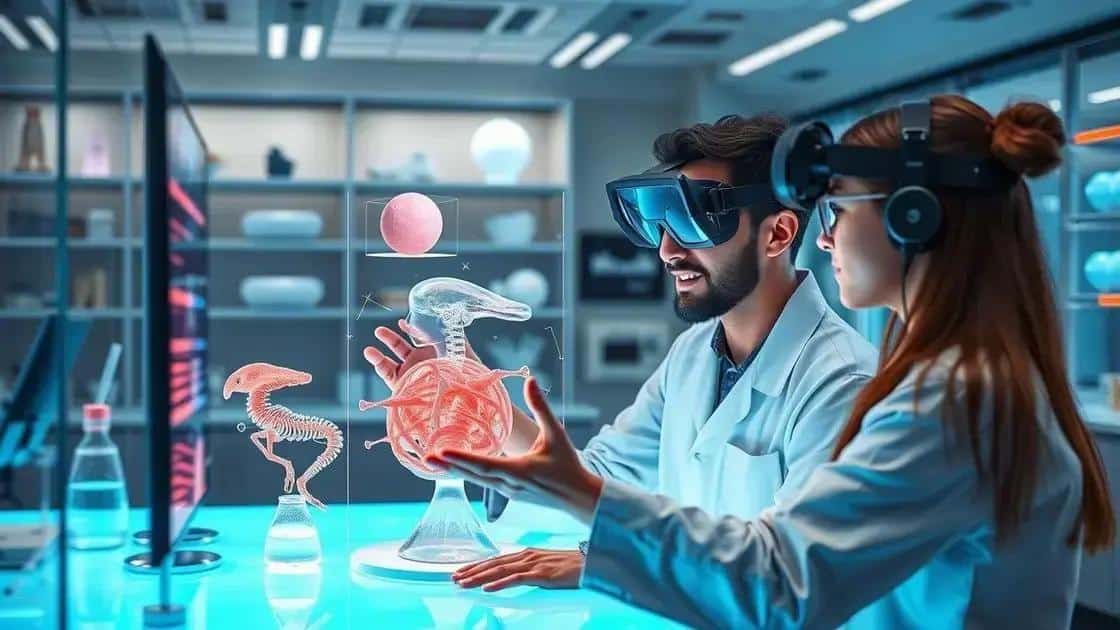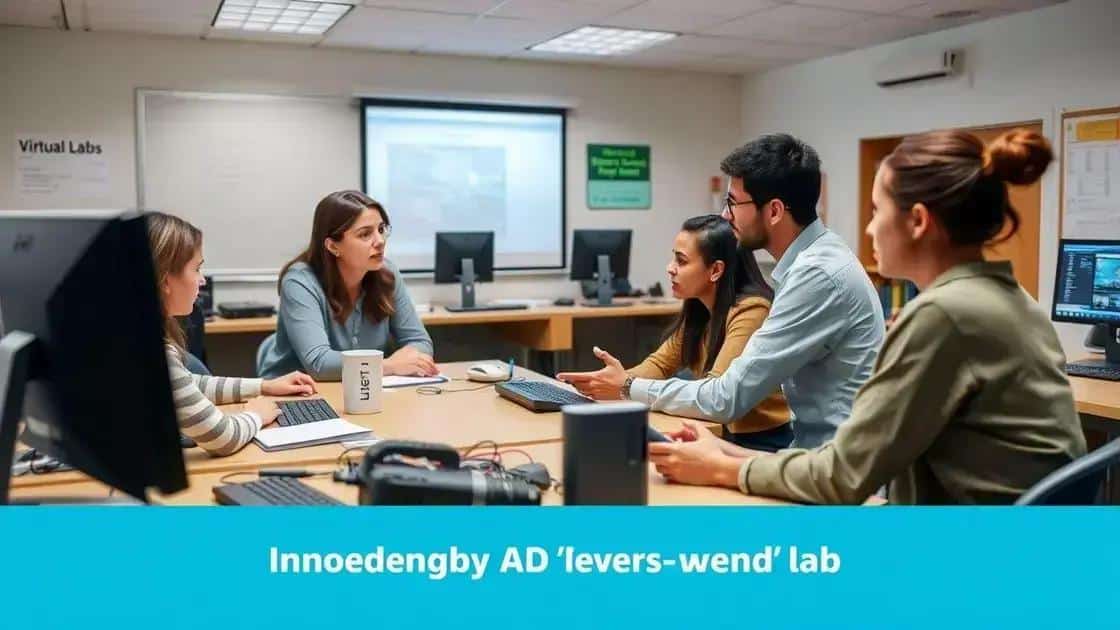Virtual lab simulations trends that will reshape learning

Virtual lab simulations enhance education by providing a safe, interactive environment where students can conduct experiments without the risks associated with physical labs, thus promoting deeper learning and accessibility.
Have you heard about virtual lab simulations trends? These innovative approaches are transforming the way we learn and practice skills, making education more interactive and engaging. Let’s dive into how these trends can impact your learning experience.
Understanding virtual lab simulations
Virtual lab simulations are transforming the educational landscape, allowing students to engage in hands-on experiments without the limitations of a physical lab. These simulations enable learners to experiment freely, making mistakes in a safe environment and gaining practical skills.
By understanding the fundamentals of virtual lab simulations, we can explore how they enhance learning. One of the significant advantages is the accessibility they provide. Students from various backgrounds can access the same quality of education, breaking down geographical barriers.
Key Features of Virtual Lab Simulations
Some of the standout features include:
- Interactive environments that mimic real-life scenarios.
- Immediate feedback to guide learners through their experiments.
- Ability to repeat experiments as many times as needed.
- Data collection and analysis tools for deeper learning insights.
These components make virtual labs a valuable resource. They engage students in a way traditional learning can’t. Imagine a chemistry class where students can mix chemicals without the fear of hazardous reactions. This is the power of virtual lab simulations.
In addition, virtual lab simulations cater to different learning styles. Visual learners benefit from interactive visuals, while kinesthetic learners thrive in the hands-on approach that these simulations offer. As technology advances, so do the possibilities for creating even more realistic and comprehensive simulation experiences.
Key trends in virtual lab technology

Key trends in virtual lab technology are shaping how students engage with science and technology. As technology advances, we see more innovative features being integrated into virtual labs. This evolution enhances the learning experience and keeps it fresh and relevant.
One notable trend is the use of augmented reality (AR). AR brings a new level of interactivity by allowing students to visualize complex concepts in 3D. Imagine dissecting a virtual frog, where students can rotate and explore every angle without any mess. This enhances understanding and keeps students more engaged.
Personalized Learning Experiences
Another important trend is the shift towards personalized learning experiences. Virtual labs now offer tailored learning paths that meet individual student needs. Instructors can track progress in real-time, allowing them to provide additional support or challenge students as needed.
- Custom learning objectives based on student performance.
- Adaptive feedback that responds to student actions.
- Real-time data analytics to monitor student engagement.
- Collaboration tools that connect students with peers worldwide.
This personalization not only boosts student confidence but also makes learning more effective. Additionally, gamification is increasingly prevalent in virtual labs. By incorporating elements of gaming, educators can motivate students. Points, badges, and leaderboards can turn learning into an exciting competition.
Lastly, the integration of cloud technology is revolutionizing access to virtual labs. Students can access lab simulations from any device with an internet connection. This flexibility allows for convenient study anywhere, anytime, making education more accessible for all.
Benefits of virtual labs in education
The benefits of virtual labs in education are numerous and significant. They offer unique opportunities for students to engage with complex subjects effortlessly. With virtual labs, learners can explore scientific concepts without the constraints of physical labs.
One major benefit is the safety factor. In traditional labs, students may be exposed to hazardous materials or dangerous equipment. However, virtual labs eliminate these risks, allowing students to experiment freely. This enhances learning since students can make mistakes and learn from them without real-world consequences.
Cost-Effective Learning
Another advantage is the cost savings associated with virtual labs. Setting up and maintaining a physical lab can be expensive. Virtual simulations reduce the need for expensive equipment and materials, making education more accessible.
- No need for physical chemicals or lab equipment.
- Reduced costs for educational institutions.
- Accessibility for students from various economic backgrounds.
- Flexibility to conduct experiments anytime and anywhere.
Furthermore, virtual labs provide instant feedback to students. They can immediately see the results of their actions, which helps with understanding cause and effect. This feedback loop is crucial in science education, where understanding processes is key.
In addition, virtual labs often incorporate interactive elements that enhance engagement. Students can participate in challenges or missions, making learning fun and competitive. This gamification aspect motivates learners to explore more, deepening their understanding of the subject matter.
As technology evolves, the ability to incorporate real-time data and analytics into virtual labs is becoming a reality. Instructors can assess student performance and adapt their teaching methods accordingly. This data-driven approach ensures a more effective learning experience for everyone involved.
Challenges and solutions for virtual lab implementation

The challenges and solutions for virtual lab implementation are crucial for ensuring these educational tools are effective and widely adopted. One of the primary challenges is the integration of technology into existing curricula. Many institutions may lack the necessary infrastructure to support virtual labs, making it harder to implement these advanced tools.
Additionally, training teachers to effectively utilize virtual lab technologies can be a hurdle. Without proper understanding and support, educators might feel overwhelmed by new software or platforms. To address this, institutions should invest in comprehensive training programs that equip teachers with the necessary skills to navigate and teach using virtual labs.
Accessibility Issues
Another significant barrier is accessibility for all students. Not all learners have equal access to devices or reliable internet connections. This can create disparities in who can benefit from virtual labs. To overcome this, schools could explore partnerships with tech companies to provide the necessary devices or consider hybrid models that blend in-person and virtual experiments.
- Implementing low-cost technology solutions.
- Offering offline resources for students with limited internet access.
- Creating community programs to lend devices to students.
- Providing flexible schedules for virtual lab access.
Technical issues also arise during implementation. Software bugs, system crashes, and other tech-related problems can frustrate both students and educators. To combat these issues, regular maintenance and updates should be prioritized. Institutions can also establish dedicated tech support teams to help resolve problems swiftly.
Moreover, ensuring stakeholders buy into the concept of virtual labs is essential. Gaining support from parents, administrators, and even students is critical. Demonstrating the effectiveness and educational value of virtual labs can help achieve this buy-in. Open houses or demonstrations can showcase these benefits to the school community.
In summary, virtual lab simulations represent a significant advancement in education, providing students with safe, engaging, and interactive learning environments. While challenges such as implementation and accessibility exist, effective solutions can overcome these barriers. By embracing technology and investing in training and resources, educators can transform the learning experience, making science and technology more accessible for all students. As the field continues to evolve, staying informed about key trends and innovations will ensure that virtual labs remain effective tools for education.
\n
\n
FAQ – Frequently Asked Questions about Virtual Lab Simulations
What are virtual lab simulations?
Virtual lab simulations are computer-based tools that provide students with online access to experiments and scientific processes in a safe environment.
How do virtual labs enhance learning?
Virtual labs allow students to practice experiments without the risks associated with physical labs, receive immediate feedback, and engage in interactive learning.
What challenges exist in implementing virtual labs?
Challenges include ensuring accessibility for all students, integrating technology into curricula, and providing adequate training for teachers.
What are the benefits of using virtual labs in education?
Benefits include increased safety, cost-effectiveness, personalized learning experiences, and improved engagement through interactive features.





